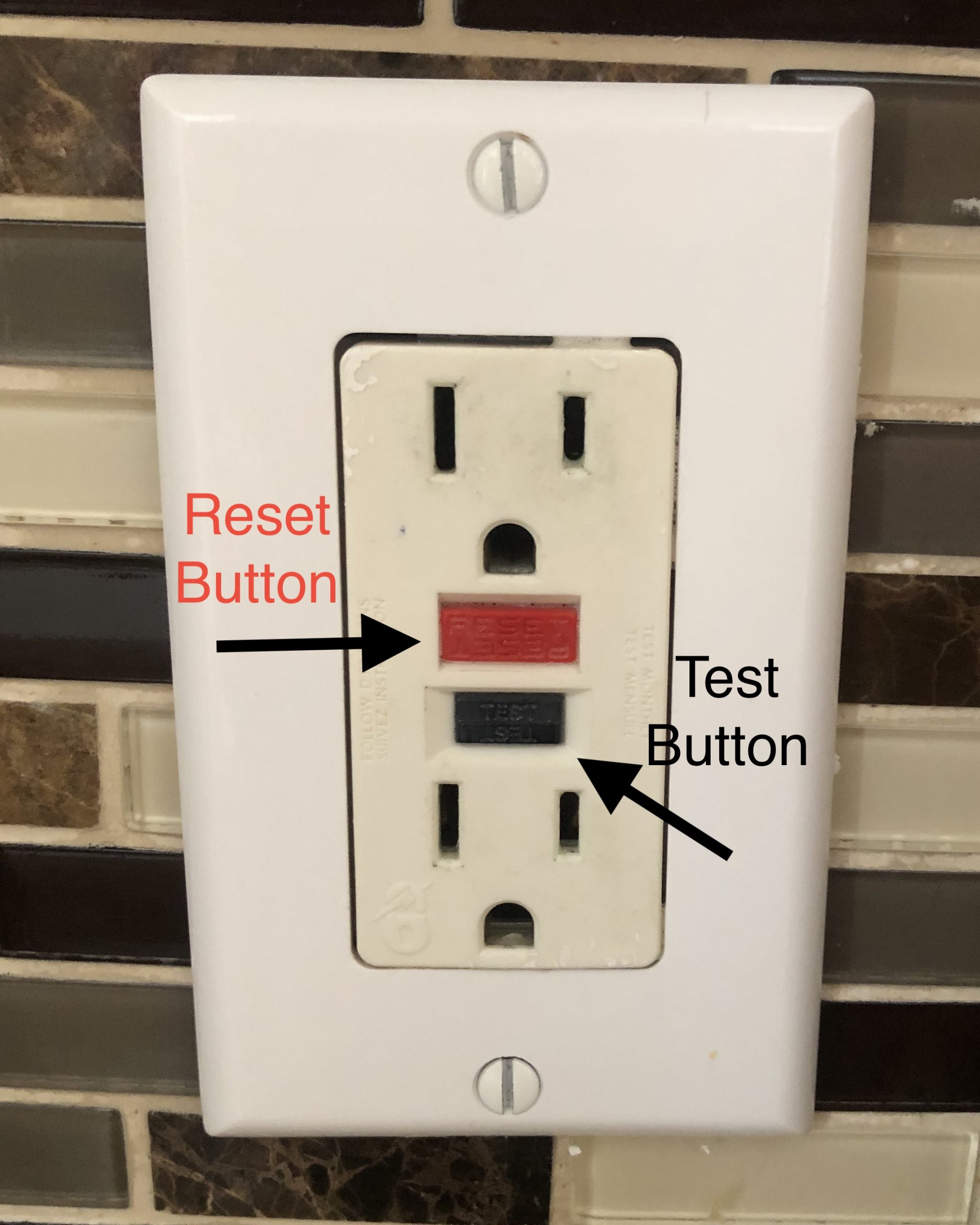Do you know what an upside-down plug means? Or how to tell if a breaker is tripped and needs resetting? If you don’t, you will soon. This electrical troubleshooting guide is perfect for both beginners and seasoned Handyman.
Major electrical issues will require a professional, but having a few tips and tricks up your sleeve is helpful – and can go along way to saving you money, and frustration.
An Outlet has Stopped Working
Has this ever happened? You go to plug in your hair dryer or your toaster, and there’s no power. It worked yesterday but today, it just won’t turn on. Frustrating.
The first thing to check is to make sure the appliance you’re trying to use still works. Unplug it, and try it on another outlet. If possible, another outlet in a different part of the home. It’s important to test the appliance on an outlet in a different area of the home in case there’s a larger issue, affecting multiple outlets on a circuit.
You test the appliance, it works. The issue must be with power going to the outlet. That’s important to know.
The next step is to locate the GFCI outlet in the area. This outlet will allow you to reset all of the outlets that are on the same electrical circuit as the GFCI. Common places for a GCFI outlet are in the bathroom, kitchen, garage, and exterior outlets.
You can identify a GFCI outlet by the black and red buttons on the outlet. The black button is for testing. The red button is to reset the outlet.
Resetting the GFCI
Press the black test button. You should hear a click. This means the outlet is working. Next, press the red button. This will reset any outlets connected to the GFCI. Plug your appliance back in and test it.
If it works, great! You’re all done. If not, there’s a few more steps to try before calling an electrician.
If the outlet is still not working, My Hassle Free Home(1) advises to go around and unplug anything that’s plugged in around that area. If in the kitchen, no need to worry about the Fridge or larger appliances. But anything else that may be using power, needs to be unplugged.
Once unplugged, try pressing the black test button, then the red reset button again.
If that does not work, it’s time to check the main electrical panel to see if a breaker has tripped.
Your main electrical panel is located on the outside of your home, or sometimes in the garage. Open the main panel and take a look at all of the breakers inside. A breaker in use should be switched to the on position. A breaker not in use should be switched in the off position. A tripped breaker will be somewhere in the middle of on and off.
If any breaker is in the middle, you have a tripped breaker. Before calling an electrician, you can try to reset the breaker yourself.
Reset a Single Breaker in Your Main Electrical Panel
To reset a breaker, move the breaker fully into the off position. Wait a few seconds, then flip to switch into the on position.
Try using your outlet again. If still not working. Reset the GFCI outlet one last time.
If after all of this troubleshooting, you’re still not getting power to the outlet, it’s time to call an electrician. Handyman Network partners with licensed electricians that are happy to come, investigate the problem, and provide you with an estimate for repairs – free of charge.
Turning off Power to your Home
There may be times when you need to turn off power to your home. For larger electrical issues or repairs, it’s best to have an electrician involved. But it’s important to know how to safely turn off power – and turn on power, from your main electrical panel.
The most common reason a homeowner will want to turn off all power to a home is when troubleshooting an issue. Usually, if multiple outlets are not working, or you’ve suddenly lost power in part or all of your home.
When resetting a single breaker, it is safe to turn just that one breaker off, then back on again to try and reset the breaker.
If turning off multiple breakers, or all of the power to the home for a full house reset, there’s steps you should take to make sure you turn power off and on safely, so you do not have a surge of power coming in or out of your house.
Steps for turning off power at the main panel
- One by one, turn each breaker into the off position.
- When all breakers are off, pull the main power lever into the off position.
- Power is now off in your home.
- To turn power back on, first, turn the main power lever into the on position.
- Once the main power is on, then one by one, turn the individual breakers into the on position.
- The power is now fully restored into your home.
- You may need to reset the GFCI outlets as well if power did not return to an outlet. Press the black test button first, then the red reset button.
By following these steps, you make sure power is both turn off and on gradually, and reduce the risk of a power surge, which could blow a fuse and create a larger electrical issue.
Other Handy Electrical Tips
Upside-Down Outlet
Do you know what an upside-down outlet means? No, it wasn’t a mistake made by an electrician. ESI (Electrical Specialists Incorporated)(2) states that an outlet installed upside-down identifies that outlet as being controlled by a switch.
Having an outlet connected to a switch is perfect for lamps in a room. A simple convenience we take for granted. Walking into a room, turning on a switch, and our floor lamp on the other side of the room turns on. It’s not uncommon, and it’s super convenient.
Having the outlet upside-down allows the electrician, and homeowner, to quickly tell which outlets are controlled by the switch. This is handy to know when it comes time to plug in the lamp you want to use, and not having to move it around to every outlet in the room to find out which plug is controlled by the switch. Simply look for the outlet that’s upside-down, and you know where to plug in your lamp. Nifty!
Remember, the switch will only turn on a lamp if the lamp is already turned on by the controls directly on the lamp. If you turn the lamp off on the lamp itself and then use the switch to try to turn the lamp back on, it will not work. You’ll need to turn the lamp back on at the lamp itself, then you can use the switch to turn it on an off from there.
That is important to remember, and to check, before calling an electrician for help.
Test Your Smoke Detectors
Did you know your smoke detectors have a button to test that they are working?
Rule-of-thumb is to test your smoke detectors twice a year, to make sure they are in good working order. An easy way to remember this is to check them whenever it’s time to change your clocks.
Press and hold the test button until the alarm sounds. Let the alarm ring for a few seconds to make sure it’s loud and clear, then push the test button again to turn it off. Easy as Pie.
Time to change the batteries on your smoke detectors? If changing batteries on one, change them on all. Chances are all other units will need batteries shortly anyway, so save yourself the trouble of hearing the low battery beep month after month, and take care of all units at the same time.
Don’t forget to test them once the new batteries are in!
What Light Bulbs Are Right for The Fixture?
I don’t know about you, but almost every light fixture in my home requires a different type of bulb. It’s impossible to remember the style and wattage you need for each one – and thankfully you don’t have to.
Every light fixture has the recommended light bulb style and wattage written somewhere on it. Usually a sticker on the fixture, sometimes it’s engraved or stamped onto the fixture. So even if you threw out the old light bulb and aren’t sure what to replace it with, your fixture will tell you. Thank goodness – because I can never remember.
Bonus tip: Don’t want to – or can’t, climb up a ladder to read what’s on a light fixture above you? Or maybe the print on the fixture is too small to read? If you have a smartphone, take a picture of the writing on the fixture. You can zoom in to read the writing, or text the picture to a friend with good eye-site and have them read it for you. Teamwork!
When in Doubt, Call For Help
Troubleshooting Electrical issues can make even a seasoned Handyman nervous from time to time. But so often, the solution is an easy fix, and following these troubleshooting guidelines will save you time and money – not to mention frustration of calling out a professional for turned out to be a quick two-minute fix.
Avoid the heartache, by following this troubleshooting guide for these common issues. The troubleshooting solutions are safe, easy, and more often than not will solve the simplest of electrical issues.
But when in doubt, or after you’ve tried everything listed above, call for help. A licensed electrician will be able to safely resolve your issue, and give you piece of mind that your house is in working order.
At Handyman Network, we partner with experienced handyman and licensed electricians to tackle your electrical needs. Depending on your project or problem, we will partner you with the best person to get the job done right.
Call us today for a free estimate and expert troubleshooting for your electrical needs. We’re happy to help, and we will work with you to get the job done – together.
References:
(1)My Hassle Free Home – YouTube Channel: https://www.youtube.com/watch?v=OUR0GBrDmSg
(2)ESI Engineering Specialists Incorporated: https://www.esinationwide.com/why-are-electrical-outlets-sometimes-upside-down.php










